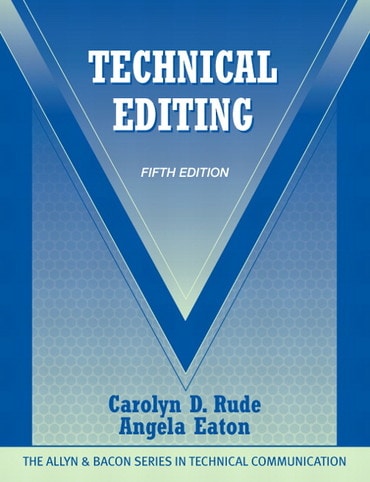
- Carolyn D. Rude |
- Angela Eaton |
Title overview
This market-leading text, which reflects recent changes in technology, workplace practices and the global marketplace, progresses from concepts and basic copyediting to comprehensive editing, management and production issues. Technical Editing approaches editing comprehensively, defining editorial responsibility not as sentence-level revisions for correctness but rather in terms of information design and the overall effectiveness of a document in helping readers understand and complete tasks. Students learn that the measure of a “good” document is in part outside that document, in the document’s “match” to the users' needs and the author's goals.
- Comprehensive attention to illustrations and digital media as well as text and print.
- Enhanced coverage of the effects on technical communication of the globalisation of world markets.
- Complete coverage of the important legal and ethical issues in communicating technical information.
- A realistic perspective on workplace practice through real-world “scenarios,” case studies, and information on current technological applications.
- Unique “before and after” examples demonstrate the effects of technical editing.
- A glossary of technical editing terms offers a handy resource and quick review.
- A new contributor, Angela Eaton of Texas Tech University--brings to this edition a long history of teaching and mentoring both undergraduate and graduate editing students, as well as many years of experience as a freelance editor. Eaton brings a fresh tone to her updates of content and pedagogy while retaining the authoritative voice of Carolyn Rude.
- Discussion and Application sections have been revised and expanded throughout to include current technology references, provide fresh examples, and reflect current practice.
- A new scenario, featuring a freelance editor, has been added to Chapter 1, which has also been substantially updated to reflect the global changes in technical editing as a field.
- Recent research on the writer-editor relationship and commenting styles has been added to Chaoter 3.
- Chapter 6, "Electronic Editing," has been entirely updated by David Dayton to reflect the most recent research, as well as current skills and processes.
- Examples about editing Web sites have been added throughout, replacing a stand-alone chapter, to support the increased role of online resources in every aspect of communication.
- The Instructor’s Manual includes new exams, new exercises, and more comprehensive editing examples, so that students can practice assessing issues beyond the paragraph level.
Table of contents
-
I. PEOPLE AND PURPOSES.
-
1. Editing: The Big Picture.
-
2. Readers, Users, Browsers, Problem Solvers.
-
3. Collaborating with Writers.
-
II. METHODS AND TOOLS.
-
4. Marking Paper Copy.
-
5. Marking Digital Copy.
-
6. Electronic Editing by David Dayton.
-
III. BASIC COPYEDITING.
-
7. Basic Copyediting: An Introduction.
-
8. Copyediting for Consistency.
-
9. Spelling, Capitalization, and Abbreviations.
-
10. Grammar and Usage.
-
11. Punctuation.
-
12. Quantitative and Technical Material.
-
13. Proofreading.
-
IV. COMPREHENSIVE EDITING.
-
14. Comprehensive Editing: Definition and Process..
-
15. Style: Definition and Sentence Structures..
-
16. Style: Verbs and Other Words.
-
17. Organization: The Architecture of Information.
-
18. Visual Design.
-
19. Editing Illustrations..
-
20. Editing for Global Contexts.
-
21. Legal and Ethical Issues in Editing.
-
22. Type and Production.
-
23. Project Management.
-
24. Client Projects.
Author bios
CAROLYN RUDE teaches professional writing and chairs the Department of English at Virginia Tech. Before becoming a professor, she worked as a technical writer and editor. She is past president and fellow of the Association of Teachers of Technical Writing. She is also a fellow of the Society for Technical Communication and winner of its Jay R. Gould Award for excellence in teaching. She believes that understanding editing has enhanced her administrative work, not just because of required writing and document design but also because of the focus of comprehensive editing on readers and purposes, reading styles, and project management.
ANGELA EATON (angela.eaton@ttu.edu<mailto:angela.eaton@ttu.edu>) is an Associate Professor of Technical Communication and Rhetoric at Texas Tech University. Her research interests include technical editing, grant writing, and technical communication practices and pedagogies. She is the owner of the technical editing and grant writing firm Angela Eaton & Associates, LLC, is a member of the Association of the Teachers of Technical Writing, and is a senior member of the Society for Technical Communication . She was the 2005-2006 winner of the Society for Technical Communication's $10,000 Research Award. Her research has been published in Technical Communication, Business Communication Quarterly, and three edited collections.